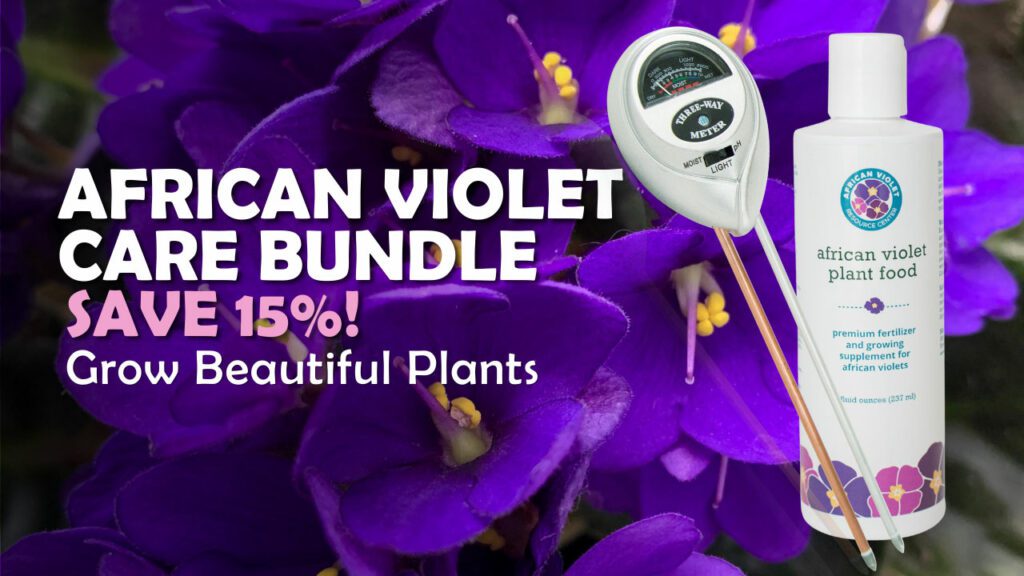One of the most popular houseplants in the world, the dainty African violet is preceded by a reputation for being a little tricky to tend to. While mastering African violet care is really a matter of nailing down a few key tricks, understanding their sensitive leaves is a critical component.
Let’s take a closer look at African violet leaves, what they can tell you about your plant, and how to keep them happy year after year.
Understanding African Violet Leaf Types
The numerous types of African violets available today all “stem” from a single variety discovered in the Tanzanian jungle in the late 1800s. Years of hybridization by enthusiastic botanists have spawned a range of distinct varieties.
African violet leaves can vary substantially from type to type, so don’t be alarmed if you bring one home that sticks out from the others. There’s nothing wrong with it, it’s just on a path of its own.
Common Leaf Shapes
- Oval
- Pointed
- Scalloped
- Long
- Serrated
- Bustle (dual leaves)
- Heart-shaped
FAQ: Why Are African Violet Leaves Fuzzy?
African violets are well known for their fuzzy foliage. But why exactly do these lovely little plants grow such nuzzle-worthy greens? According to the African Violet Society of America, the violet’s velvety coat does more than just make plant lovers swoon. (Go figure!)
- Protects the crown: The hairs lean toward the tip of the plant, rerouting raindrops off the leaves and away from the center of the plant. This helps prevent crown rot and other complications.
- Temperature control: The fuzzy layer provides protection from changes in air temperature which can shock the delicate plant.
- Pest patrol: Larger pests are barred from the actual plant tissue by the hairs on the leaves. When met with a mouthful of fuzz, many pests will move on to a different plant.
Sensitivity & African Violet Leaves
In their natural habitat, African violets are protected from the elements by the lush jungle canopy. The dainty houseplant in your home is equally sensitive, and it’s your job to do the protecting.
Water Sensitivity
Rule number one of African violet care: Keep the leaves dry!
Wet leaves can lead to two conflicting complications: first, cold water can cause discoloration akin to frostbite (there’s no ice water in the jungle!); secondly, because the plants rarely see direct sunlight in their natural environment, they’re not equipped to handle both moisture and sunshine on their leaves. The water will amplify the rays of the sun and burn your plant.
Unfortunately, neither ailment is treatable. The discoloration will persist throughout the leaf’s lifetime.
Temperature Sensitivity
African violets are vulnerable to temperature extremes. That’s why, although this plant likes a lot of sunlight, it’s best to keep it away from the window’s ledge. The hot rays of the sun are too intense and will cause African violet leaves to wilt and wither.
Your plant doesn’t like it chilly either. If you notice your African violet leaves curling under, your plant is probably catching a cold. Move to an environment around 70 degrees and be sure to water with room-temperature or tepid water, never cold.
FAQ: Are African Violet Leaves Sensitive to Sunlight?
A fairly common misconception, African violets are NOT a low-light plant. In fact, they thrive in well-lit places. African violet leaves’ sensitivity to temperature (such as harsh, direct sunlight) is the reason these plants do not do well in extremely sunny windows.
Houseplant Pro-Tip: If your African violet’s leaves are growing upward, this indicates a lack of light. Move it to a sunnier spot!
Caring for African Violet Leaves
First and foremost, your African violet’s longevity relies on it having the proper environment to grow. So, before reading the following advice, double-check that you have taken all of the factors above into consideration.
All good? Here’s how to care for African violet leaves as time “grows” on!
Removing Old Leaves
African violets produce new leaves from the center out, pushing older leaves down into lower layers. Because African violet leaves grow quickly, we recommend trimming the bottom three or four leaves every month. Removing the oldest leaves, which will eventually die, allows your plant to put more energy into growing healthy new leaves and bright blooms.
Houseplant Pro Tip: If your bottom leaves are still vigorous but it’s time for a trim, consider propagating your African violet. It’s easy!
Pruning African Violet Leaves
There are two methods to remove leaves from your plant: you can pinch prune or use a pruning tool. With both methods, remove the leaf as close to the base stem as possible, but take care to avoid cutting into it. Always wash and sterilize your hands and tools before pruning.
- Pinch pruning: Take the leaf between your thumb and forefinger, pinch with your fingertips, and tug outward.
- Shears or scissors: Remove the leaf with a sharp tool, trimming as flush as possible with the main stem.
FAQ: Why Does My African Violet Have a Long Neck?
Don’t be alarmed if you notice your plant developing a leafless, tree trunk-like segment near the soil. This is fairly common. African violet leaves grow from the top of the plant, so the bottom of the stem becomes bare as older leaves are trimmed or die.
This should be corrected for more than aesthetic reasons; the vulnerable “neck” will eventually bow under the weight of your plant. A bare stem makes your plant more susceptible to root rot too.
Repotting a Long-Necked African Violet
- First, remove any African violet leaves that are discolored, old, or damaged.
- Remove the plant from the pot and prune straggly or out-of-place leaves to maintain the plant’s shape.
- Remove the bottommost layer of soil (equivalent to the amount of neck sticking above the soil).
- Add a thin layer of fresh potting mix to the bottom of the pot for a nutrient boost.
- Place the plant back in the pot and cover with fresh soil up to the first layer of leaves, fully covering the bare neck.
- You can place the plant in a plastic bag or container for the first few weeks; this helps your plant boost humidity and establish healthy roots.
Did we miss something? “Leaf” your question in our Facebook group.
Join the African Violet Club!
Whether you’re a green or seasoned grower, African Violet Resource Center has everything you need to help your plant grow vibrant and strong. Explore our other articles, visit our online shop, and connect with other houseplant lovers in our Facebook group to learn everything you need to know about this rewarding hobby!
More Great African Violet Resources
5 Tips to Keep Your African Violet Alive for Years to Come
3 Steps to Mastering the Art of African Violet Care
Making Sense of African Violet Potting Mix (And How to Make it Too!)







